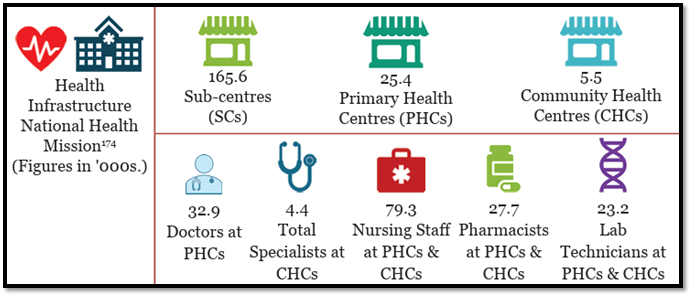Syllabus: GS2/Issues Relating to Development; Health; GS3/Infrastructure
Context
- Recently, the Supreme Court of India has emphasized the critical need to prioritize education, hygiene, and healthcare in rural areas to foster holistic development.
Key Observations by the Supreme Court
- Focus on Basic Infrastructure: The court underscored that ensuring access to quality education, healthcare, and hygiene is essential for improving the living standards of rural populations.
- Budgetary Allocations: It suggested that states allocate at least 10-15% of their budgets to enhance rural infrastructure, addressing long-standing disparities in resource distribution.
- Libraries vs. Basic Needs: The court acknowledged the importance of public libraries, and stressed that immediate priorities should include addressing hunger, healthcare, and education.
Rural Landscape in India: Positive Transformations in Rural India
- India is home to 6.65 lakh villages, with 2.68 lakh Gram Panchayats and Rural Local Bodies, which form the backbone of the nation’s rural landscape.
- National Multidimensional Poverty Index (MPI) Report: Declined from 24.85% to 14.96% between 2015-16 and 2019-21 (13.5 crore individuals escaped multidimensional poverty during this period).
- Rural Internet Connectivity: India had 954.40 million internet subscribers (March 2024). Out of this, 398.35 million were rural internet subscribers.
- Income Distribution (Gini Coefficient): Declined from 0.266 in FY22-23 to 0.237 in FY23-24, for rural areas.
- Rural Wage Growth: As per data from the Labour Bureau, rural wages in FY25 showed a growth of above 4% each month year-on-year:
- Agriculture wages grew by 5.7% for men and 7% for women.
- Non-agricultural wages grew by 5.5% for men and 7.9% for women.
- Annual Status of Education Report (ASER) of 2024 reveals improvements in rural education, including pre-primary enrollment and learning outcomes, with a focus on foundational literacy and numeracy, and increased digital literacy among older children.
Key Government Initiatives
- Education in Rural India:
- Samagra Shiksha Abhiyan: Integrates Sarva Shiksha Abhiyan (SSA), Rashtriya Madhyamik Shiksha Abhiyan (RMSA), and teacher education programs.
- Mid-Day Meal Scheme: Aims to improve nutrition and attendance rates.
- Digital India Initiative: Promotes e-learning and smart classrooms in rural schools.
- Beti Bachao Beti Padhao: Encourages education for girl children.
- Health & Hygiene in Rural India:
- Swachh Bharat Abhiyan (G): Currently in Phase 2 the focus is on maintaining the ODF status, managing solid and liquid waste by 2024-25 and transitioning all villages from ODF to the ODF Plus model.
- Other schemes include Deendayal Antyodaya Yojana-NRLM, Ayushman Bharat Yojana (PM-JAY), Poshan Abhiyan, Jan Aushadhi Yojana, Total Sanitation Campaign, National Rural Drinking Water Programme, and National Rural Health Mission (2005).

- For Betterment of Socio-Economic Conditions:
- Water Supply – Jal Jeevan Mission (extended until 2028): Operation and maintenance of rural piped water supply schemes through a citizen-centric approach, known as ‘Jan Bhagidhari’.
- India Post as a Catalyst for Rural Economy: 1.5 lakh rural post offices, India Post Payment Bank, and 2.4 lakh Dak Sevaks.
- Pradhan Mantri Gram Sadak Yojana (PMGSY) – Roads: rural connectivity through a single all-weather road.
- Pradhan Mantri Awaas Yojana-Gramin (PMAY-G) – Housing
Challenges in Rural Development
- Financial Constraints: States often cite limited budgets as a barrier to implementing comprehensive rural development programs.
- Inadequate Infrastructure: Many villages still lack basic amenities like clean drinking water, functional schools, and healthcare services.
- Lack of Policy Focus: The absence of targeted policies for rural areas has led to uneven development and persistent inequalities.
Way Forward
- Integrated Development Approach: Governments must adopt a holistic strategy that simultaneously addresses education, healthcare, and hygiene to ensure sustainable rural development.
- Corporate Social Responsibility (CSR): The court suggested leveraging CSR funds to establish e-libraries and other essential facilities in rural areas.
- Community Participation: Empowering local communities to take ownership of development initiatives can lead to more effective and sustainable outcomes.
Previous article
Lok Sabha Passes Waqf (Amendment) Bill, 2025
Next article
Cape Town Convention